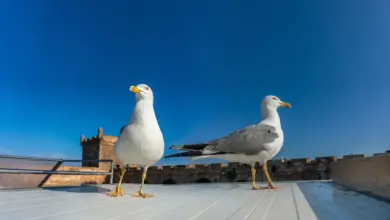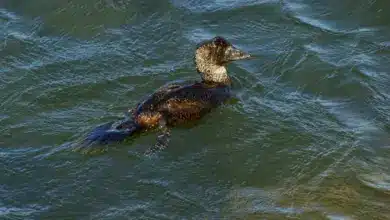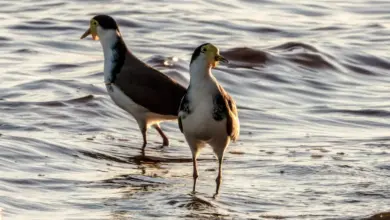Mottled Ducks
The Mottled Ducks or Mottled Mallards (Anas fulvigula) – also known as Dusky Ducks, Florida Ducks or Mottled Mallards – are medium-sized dabbling ducks. The ducks are fairly common within their restricted range; they are resident all-year round and do not migrate.
The Mottled Duck is intermediate in appearance between female Mallard and American Black Duck. It is closely related to both species, and is sometimes considered a subspecies of the Mottled Duck – however, this has been refuted.
Mottled Ducks will readily interbreed with closely related species – the American Black Duck and the Mallard; and produce fertile hybrids.
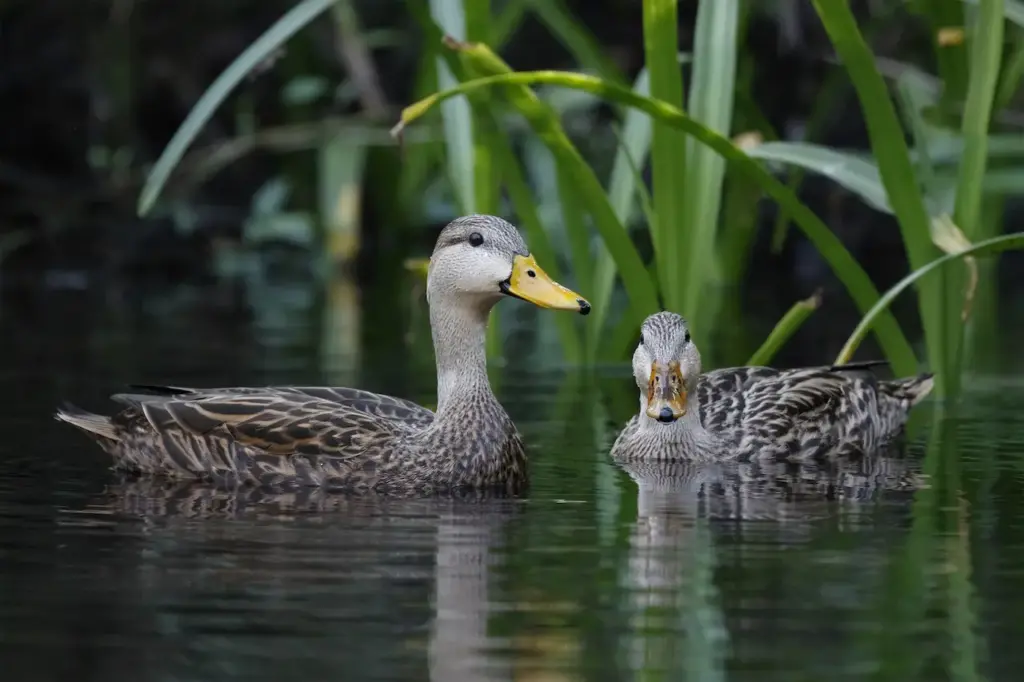
The Mottled Ducks or Mottled Mallards (Anas fulvigula) – also known as Dusky Ducks, Florida Ducks or Mottled Mallards – are medium-sized dabbling ducks. The ducks are fairly common within their restricted range; they are resident all-year round and do not migrate.
The Mottled Duck is intermediate in appearance between female Mallard and American Black Duck. It is closely related to both species, and is sometimes considered a subspecies of the Mottled Duck – however, this has been refuted.
Mottled Ducks will readily interbreed with closely related species – the American Black Duck and the Mallard; and produce fertile hybrids.
Alternate (Global) Names
Spanish: Ánade Jaspeado, Pato Tejano, pato texano … Italian: Germano maculato … French: Canard brun, Canard de Floride, Canard obscur … German: Floridaente, Stockente-fulvigula … Danish: Floridagråand … Dutch: Gevlekte Floridaeend, Gevlekte Florida-eend … Norwegian: Golfand … Swedish: Fläckand … Estonian: rand-sinikaelpart … Finnish: Amerikansinisorsa, suolakkosorsa … Japanese: madaragamo, >????? … Polish: krzyzówka florydzka, krzy?ówka florydzka … Russian: ?????????? ????? … Slovak: kacica pobrežná
There are two distinct populations of Mottled Ducks.
- Florida Mottled Duck or Florida Mallard (Anas fulvigula fulvigula) – Nominate Race
- Range: Resident in central and south Florida (south of Tampa) and occasionally strays north to Georgia. The same disjunct distribution pattern was also historically found in the local Sandhill Cranes.
- ID: Plumage is slightly lighter and less heavily marked than that of the subspecies.
- Mottled Duck (Anas fulvigula maculosa)
- Range: Found from the gulf coast of Alabama through Texas to northern Mexico (Tamaulipas) (Stutzenbaker, 1988). Outside the breeding season individual birds may venture as far south as to Veracruz (southeastern Mexico).Along the Gulf of Mexico coast, the Mottled Duck is one of the most frequently banded waterfowl. This is due in part to the fact that it is mostly non-migratory. Approximately one out of every twenty mottled ducks is banded.
Description
The adult Mottled Duck is 44–61 cm (17–24 in) long from head to tail. It has a dark body, lighter head and neck, orange legs and dark eyes.
Both sexes have a shiny green-blue speculum (wing patch), which is not bordered with white as with the Mallard.
Males and females are similar, but the male’s bill is bright yellow, whereas the female’s is deep to pale orange, occasionally lined with black splotches around the edges and near the base. The plumage is darker than in female Mallards, especially at the tail, and the bill is yellower. In flight, the lack of a white border to the speculum is a key difference.
The two subspecies are intermediates between female Mallards and American Black Ducks. The Florida Mottled Duck is closer to the Mallard in appearance; while the Mottled Duck looks more like an American Black Duck. The physical differences are mostly noted in the lighter head being clearly separated from the darker breast in Mottled Duck, but much less so in Florida Mottled Duck. The American Black Duck is darker than most Mottled Ducks, and its wing-patch is more purple than blue. The behavior and voice are the same as the Mallard.
Since the ranges of the two Mottled Duck species don’t overlap, they can only be confused with female Mallards and American Black Ducks. However, especially female American Black Ducks are often only reliably identified by their dark purple speculum (wing patch).
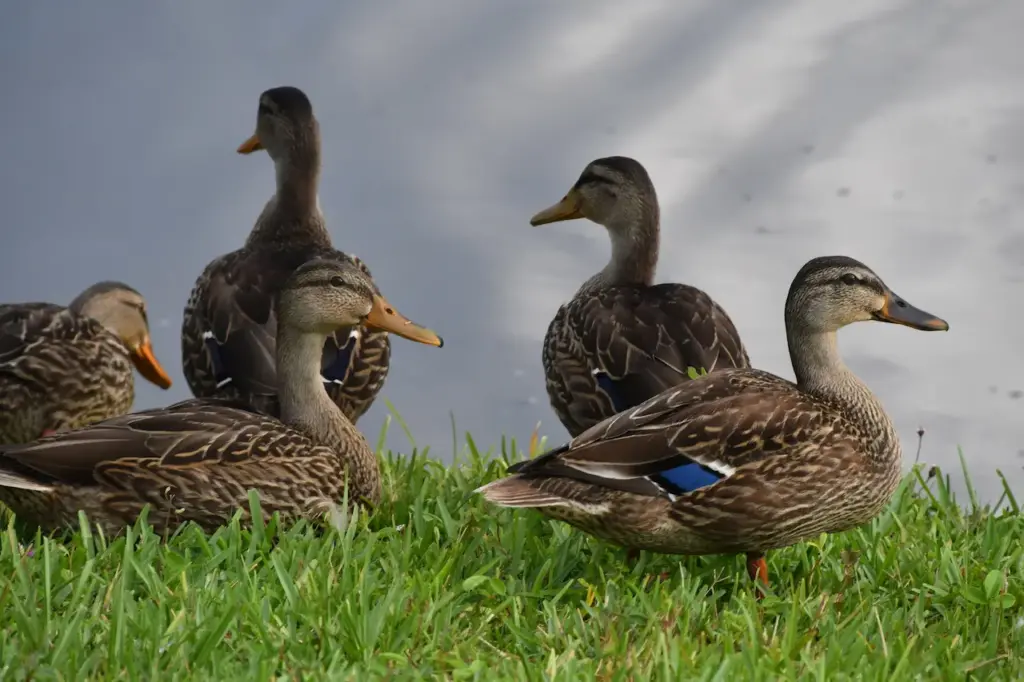
Breeding / Nesting
The breeding habitat is coastal marshes. The nest is built on the ground amongst vegetation, such as bull-rush and marsh grass.
Status
The Mottled Duck populations are stable for now with 50.000-70.000 individuals (BirdLife International 2004).
However, habitat destruction and excessive hunting post threads to this species existence. As compatible mates become more and more unavailable, hybridization will increase which could further reduce its gene pool and eventually cause it to disappear as a distinct taxon (Rhymer and Simberloff 1996).
This particularly applies to the Florida Duck (Mazourek and Gray 1994). Within its small range habitat loss due to urbanization and draining of wetlands has reduced available habitat.
More Duck Resources
Diet / Feeding
Mottled Ducks feed by dabbling in shallow water, and grazing on land. They mainly eat plants, but also some mollusks and aquatic insects.
Ducks generally feed on larvae and pupae usually found under rocks, aquatic animals, plant material, seeds, small fish, snails and crabs.
Feeding Ducks …
We all enjoy ducks and many of us offer them food to encourage them to come over and stay around – and it works! Who doesn’t like an easy meal!
However, the foods that we traditionally feed them at local ponds are utterly unsuitable for them and are likely to cause health problems down the road. Also, there may be local laws against feeding this species of bird – so it’s best to check on that rather than facing consequences at a later stage.
- Foods that can be fed to Ducks, Geese and Swans to survive cold winters and remain healthy when food is scarce in their environment.
Please note that feeding ducks and geese makes them dependent on humans for food, which can result in starvation and possibly death when those feedings stop. If you decide to feed them, please limit the quantity to make sure that they maintain their natural ability to forage for food themselves – providing, of course, that natural food sources are available.
Alternate (Global) Names
Spanish: Ánade Jaspeado, Pato Tejano, pato texano … Italian: Germano maculato … French: Canard brun, Canard de Floride, Canard obscur … German: Floridaente, Stockente-fulvigula … Danish: Floridagråand … Dutch: Gevlekte Floridaeend, Gevlekte Florida-eend … Norwegian: Golfand … Swedish: Fläckand … Estonian: rand-sinikaelpart … Finnish: Amerikansinisorsa, suolakkosorsa … Japanese: madaragamo, >????? … Polish: krzyzówka florydzka, krzy?ówka florydzka … Russian: ?????????? ????? … Slovak: kacica pobrežná
There are two distinct populations of Mottled Ducks.
- Florida Mottled Duck or Florida Mallard (Anas fulvigula fulvigula) – Nominate Race
- Range: Resident in central and south Florida (south of Tampa) and occasionally strays north to Georgia. The same disjunct distribution pattern was also historically found in the local Sandhill Cranes.
- ID: Plumage is slightly lighter and less heavily marked than that of the subspecies.
- Mottled Duck (Anas fulvigula maculosa)
- Range: Found from the gulf coast of Alabama through Texas to northern Mexico (Tamaulipas) (Stutzenbaker, 1988). Outside the breeding season individual birds may venture as far south as to Veracruz (southeastern Mexico).Along the Gulf of Mexico coast, the Mottled Duck is one of the most frequently banded waterfowl. This is due in part to the fact that it is mostly non-migratory. Approximately one out of every twenty mottled ducks is banded.
Description:
The adult Mottled Duck is 44–61 cm (17–24 in) long from head to tail. It has a dark body, lighter head and neck, orange legs and dark eyes.
Both sexes have a shiny green-blue speculum (wing patch), which is not bordered with white as with the Mallard.
Males and females are similar, but the male’s bill is bright yellow, whereas the female’s is deep to pale orange, occasionally lined with black splotches around the edges and near the base. The plumage is darker than in female Mallards, especially at the tail, and the bill is yellower. In flight, the lack of a white border to the speculum is a key difference.
The two subspecies are intermediates between female Mallards and American Black Ducks. The Florida Mottled Duck is closer to the Mallard in appearance; while the Mottled Duck looks more like an American Black Duck. The physical differences are mostly noted in the lighter head being clearly separated from the darker breast in Mottled Duck, but much less so in Florida Mottled Duck. The American Black Duck is darker than most Mottled Ducks, and its wing-patch is more purple than blue. The behavior and voice are the same as the Mallard.
Since the ranges of the two Mottled Duck species don’t overlap, they can only be confused with female Mallards and American Black Ducks. However, especially female American Black Ducks are often only reliably identified by their dark purple speculum (wing patch).
Breeding / Nesting

The breeding habitat is coastal marshes. The nest is built on the ground amongst vegetation, such as bull-rush and marsh grass.
Status
The Mottled Duck populations are stable for now with 50.000-70.000 individuals (BirdLife International 2004).
However, habitat destruction and excessive hunting post threads to this species existence. As compatible mates become more and more unavailable, hybridization will increase which could further reduce its gene pool and eventually cause it to disappear as a distinct taxon (Rhymer and Simberloff 1996).
This particularly applies to the Florida Duck (Mazourek and Gray 1994). Within its small range habitat loss due to urbanization and draining of wetlands has reduced available habitat.
Relevant Resources
Diet / Feeding
Mottled Ducks feed by dabbling in shallow water, and grazing on land. They mainly eat plants, but also some mollusks and aquatic insects.
Ducks generally feed on larvae and pupae usually found under rocks, aquatic animals, plant material, seeds, small fish, snails and crabs.
Feeding Ducks …
We all enjoy ducks and many of us offer them food to encourage them to come over and stay around – and it works! Who doesn’t like an easy meal!
However, the foods that we traditionally feed them at local ponds are utterly unsuitable for them and are likely to cause health problems down the road. Also, there may be local laws against feeding this species of bird – so it’s best to check on that rather than facing consequences at a later stage.
- Foods that can be fed to Ducks, Geese and Swans to survive cold winters and remain healthy when food is scarce in their environment.
Please note that feeding ducks and geese makes them dependent on humans for food, which can result in starvation and possibly death when those feedings stop. If you decide to feed them, please limit the quantity to make sure that they maintain their natural ability to forage for food themselves – providing, of course, that natural food sources are available.

